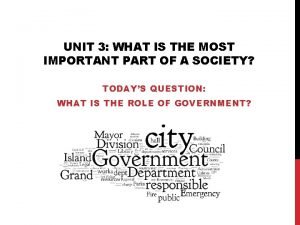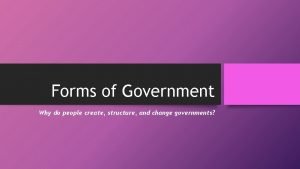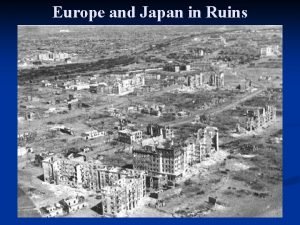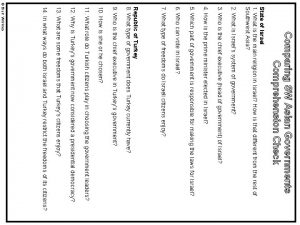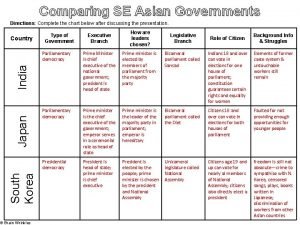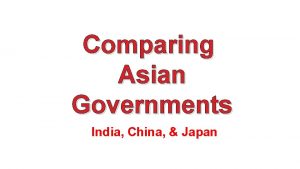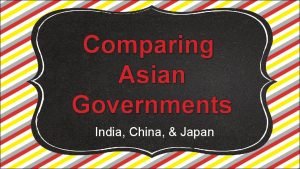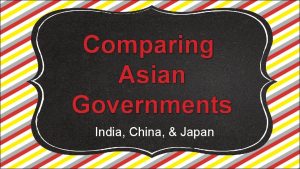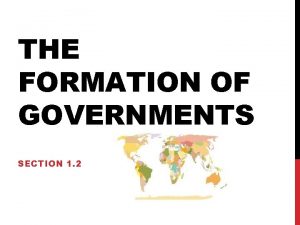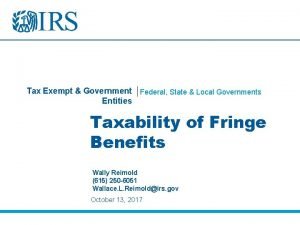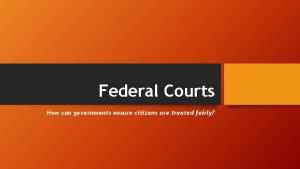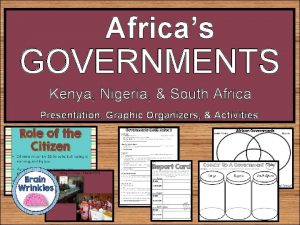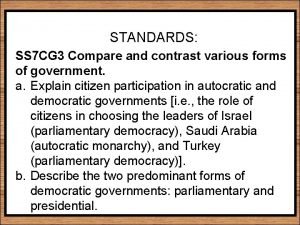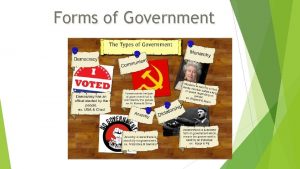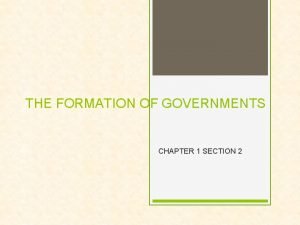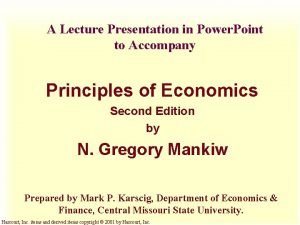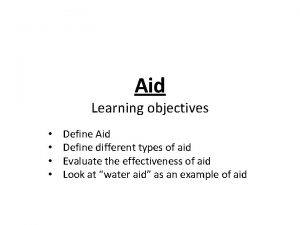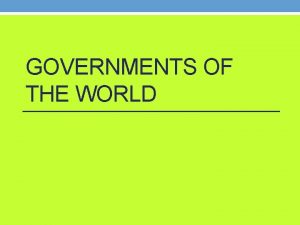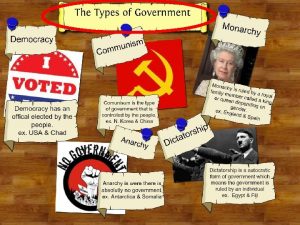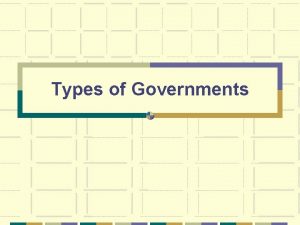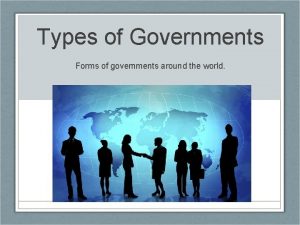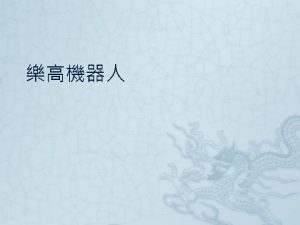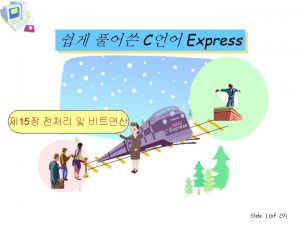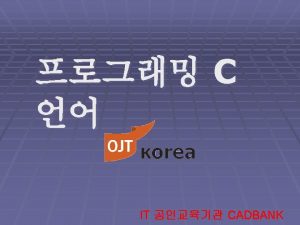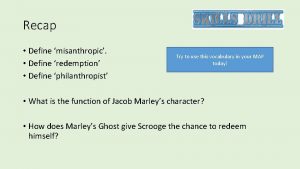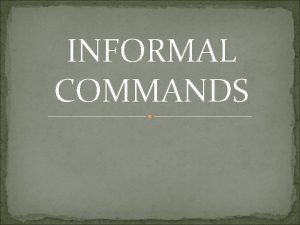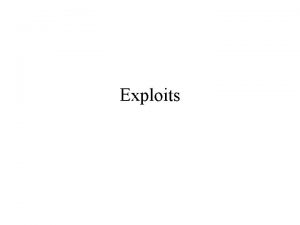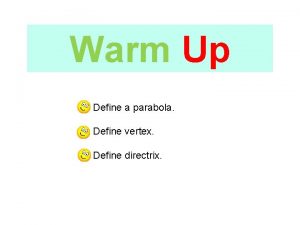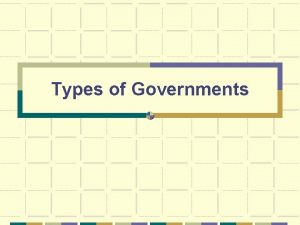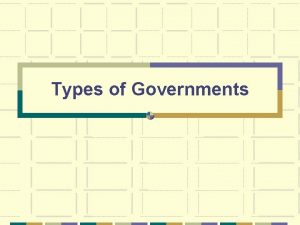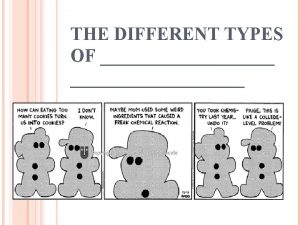Types of Governments 1 Define the different types



















- Slides: 19

Types of Governments 1

Define the different types of governments (i. e. , democracy, autocracy, oligarchy, monarchy, and dictatorship). 2

Democracy In a democracy, the government is elected by the people. Everyone who is eligible to vote has a chance to have their say over who runs the country. It is distinct from governments controlled by a particular social class or group (aristocracy; oligarchy) or by a single person (despotism; dictatorship; monarchy). A democracy is determined either directly or through elected representatives. 3

Autocracy Government by a single person having unlimited power; despotism (domination through threat of punishment and violence). 4

Oligarchy A government in which a few people such as a dominant clan or clique have power. 5

Monarchy Monarchies- One of the oldest forms of government that dates back to prehistory. A monarchy is a government where there is only one totalitarian ruler who holds office for life, or until they are overthrown in revolution. In monarchies legitimacy and succession is almost always achieved through heredity. Although, in some monarchies legitimacy through heredity is bolstered by spiritual mandate i. e. Divine Right of Kings. Monarchies gain financial support through taxation of various forms, and by keeping close watch on the nobility/military forces of the kingdom. Absolute Monarchy vs. Constitutional Monarchy? 6

Dictatorship A country ruled by a single leader. The leader has not been elected and may use force to keep control. In a military dictatorship, the army is in control. 7

Anarchy is a situation where there is no government. This can happen after a civil war in a country, when a government has been destroyed and rival groups are fighting to take its place. Anarchists are people who believe that government is a bad thing in that it stops people organizing their own lives. 8

Capitalist In a capitalist or free-market country, people can own their own businesses and property. People can also buy services for private use, such as healthcare. But most capitalist governments also provide their own education, health and welfare services. 9

Communist In a communist country, the government owns property such as businesses and farms. It provides its people's healthcare, education and welfare. Karl Marx's utopian society in which there is no government or social classes, no monetary system, and all factors of production are held in common. In communist society every person is required to work according to their abilities, and products are distributed according to need. Communism requires a selfless devotion to society whereby the good of the whole always supercedes individual wants. 10 (Utilitarianism

Republic A republic is a country that has no monarch. The head of the country is usually an elected president. Voters generally elect representatives 11

Revolutionary If a government is overthrown by force, the new ruling group is sometimes called a revolutionary government. 12

Totalitarian This is a country with only one political party. People are forced to do what the government tells them and may also be prevented from leaving the country. 13

Feudalism A middle ages practice of organizing society based on land holding and agriculture into a strictly class based society. The society consisted of royalty, nobility, and serfs or vassals. The royalty levied and collected taxes and required homage and military strength from the nobility. The nobility would receive large tracts of land (called fiefdoms or small kingdoms) for their loyalty, military assistance, and pecuniary/monetary support of the king. The serfs/vassals would in turn farm the nobilities land paying rent and protection fees to the nobility, and towards the end of feudalism serfs would purchase land from the nobility. In feudalism their was little to NO upward social mobility. . 14

Mercantilism The main purpose of society was to obtain as much gold and silver (bullion) within a country's borders as possible, which would theoretically increase a countries wealth. Mercantilism thus saw trade as a zero sum game. In other words mercantilists believed that by exporting to other countries and importing as little as possible, coupled with tariffs, they would be able to become the richest most powerful country by accumulating huge bullion reserves. This school of thought was fundamentally economically flawed. It caused artificial inflation. This resulted in merely driving up domestic prices and create black markets for imported goods. 15

Constitutional/Liberal Democracies. Constitutional/Liberal democracies are governments in which a written constitution guides the decisions of a nation, ensures basic human rights, and divides powers among the different parts of government— usually powers are divided among executive, legislative, and judicial branches. Government officials are elected by a vote of the people, but the specifics of appointment to office and exactly how the different parts of government are populated varies from country to country 16

Parliamentary Systems- The parliamentary system is a form of democracy in which the populace elects representatives. From this pool of representatives an executive is chosen either by appointment from the head of state (such as a king or queen's appointment), or threw nomination and affirmation from the parliamentary body. 17

Socialism All factors of production are owned by a central government and administered through a huge government bureaucracy. Unlike in communism private property is permitted in socialism, but there are no social classes in socialism. There is private ownership at some levels, but government controls all social programs, industry and labor. 18

Fascism A fascist government is characterized by one totalitarian ruler, which micromanages every aspect of society with his closest advisors and secret police force. Fascism is a form of government that usually has the characteristics of extreme nationalism (jingoism), racism, eugenics, violence, propaganda, censorship, and economic and social conformity. Fascism took hold in the mid 19 th century and afflicted Germany under Hitler, Spain under Franco, and Italy under Mussolini. The fascist societies rely on fear and common enemies to bind people together and bend them to the will of the totalitarian regime. 19
 Different kind of governments
Different kind of governments Why do people create structure and change governments
Why do people create structure and change governments What are three political problems postwar governments faced
What are three political problems postwar governments faced Governments comprehension check
Governments comprehension check Comparing sw asian governments
Comparing sw asian governments Is japan a unitary state
Is japan a unitary state Comparing asian governments
Comparing asian governments Comparing asian governments
Comparing asian governments Centre region council of governments
Centre region council of governments Comparing african governments
Comparing african governments The formation of governments 1-2
The formation of governments 1-2 Are local governments tax exempt
Are local governments tax exempt Are city governments tax exempt
Are city governments tax exempt Comparing sw asian governments comprehension check
Comparing sw asian governments comprehension check How can governments ensure citizens are treated fairly
How can governments ensure citizens are treated fairly How do the governments of kenya and nigeria compare?
How do the governments of kenya and nigeria compare? Comparing sw asian governments
Comparing sw asian governments How are governments classified
How are governments classified The formation of governments 1-2
The formation of governments 1-2 Governments can sometimes improve market outcomes
Governments can sometimes improve market outcomes
